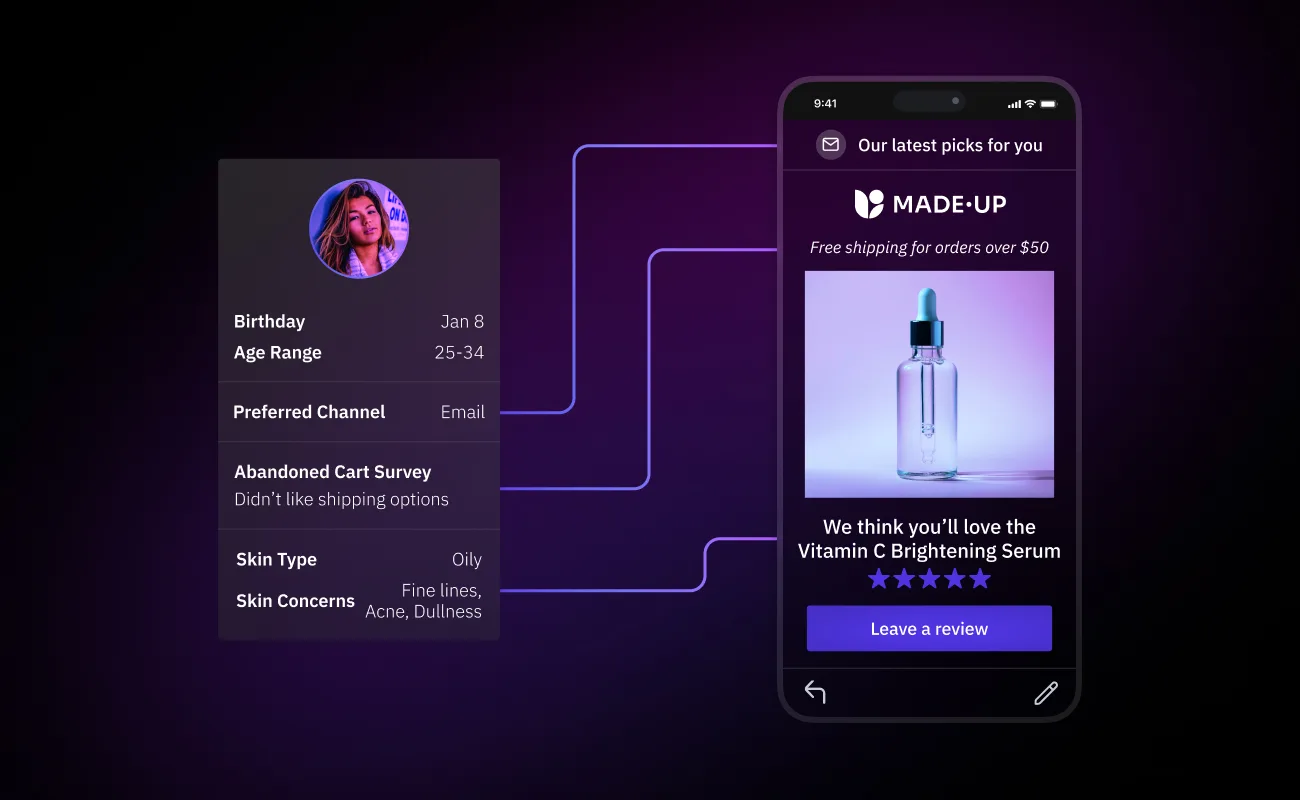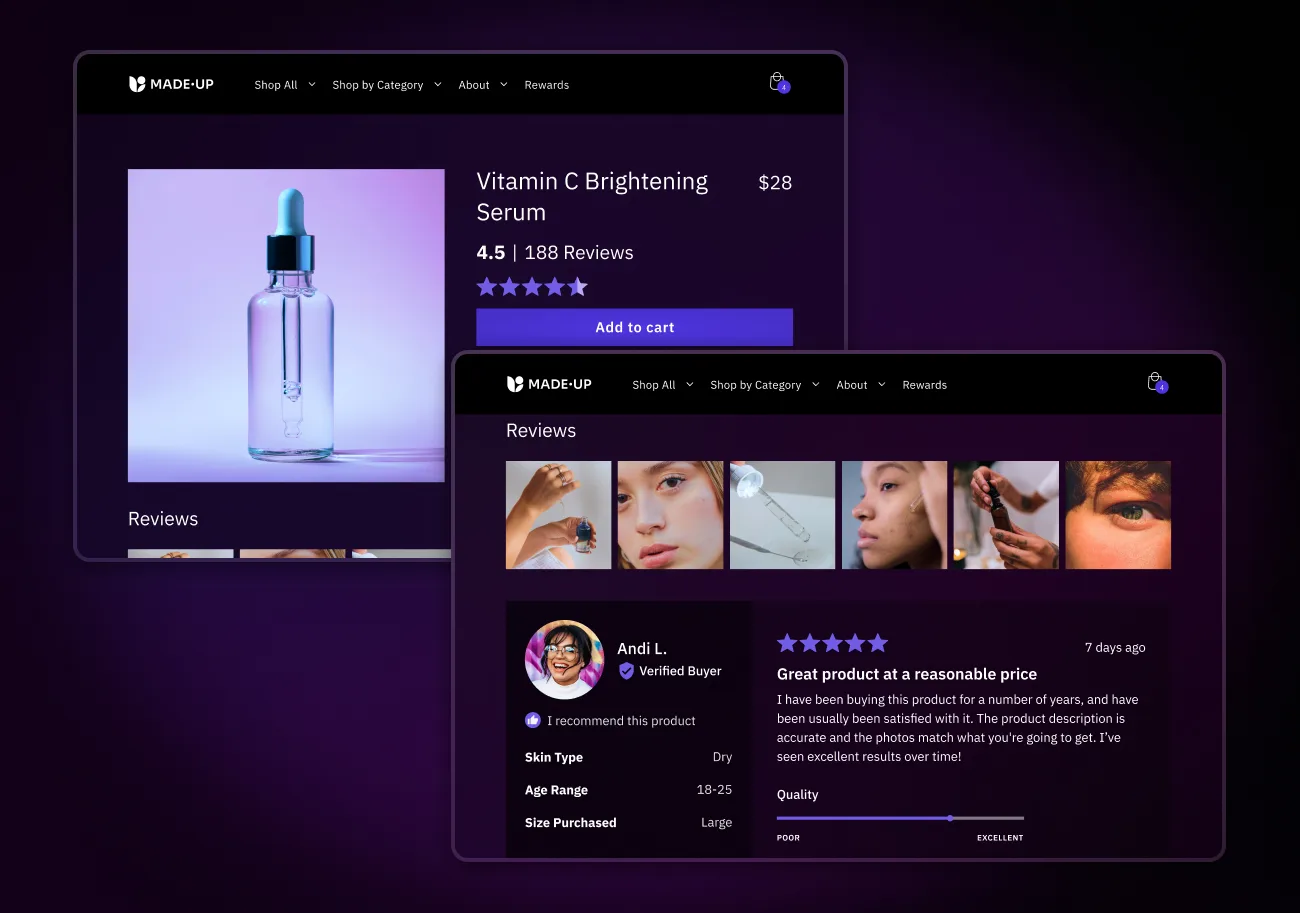
- Customer Experience
15 Bad Customer Experience Examples (and How to Fix Them)
Lindsay Kolinsky | Mar 17, 2025
Apr 10, 2024 | 14 minute read

Megan Wenzl
Content Marketing Manager
Differentiate your brand by implementing these 12 strategies to elevate the ecommerce customer journey. An exceptional ecommerce encounter can boost revenue, cut expenses, and enhance customer loyalty for long-term success.
In the world of ecommerce, competition is fierce. Customers are notoriously noncommittal, savvy, and difficult to please. Even slight inconveniences in the experience can result in a customer bouncing from your site to the sites of your competitors.
In this hyper-connected world, a frictionless customer experience is paramount, but it must also be authentically designed to capture and retain the attention of discerning shoppers.
Stand out from the competition with these 12 strategies to enhance ecommerce customer experience (CX). A good customer experience might coast well enough, but a great ecommerce experience will increase revenue, reduce costs, improve customer retention, and communicate your brand’s ethos for a successful online operation.
This guide explains 12 proven methods or strategies to improve your ecommerce customer experience and thereby revenue, customer retention, and brand reputation. Each of these points highlights different elements of the online experience (some of which are often overlooked) and a few low-hanging-fruit methods for easy execution and maintenance.
Personalization incorporated on an online site creates a tailored, refined, and efficient shopping experience. When a shopping experience incorporates personalization based on customer behavior, customers can find products that apply to them much more conveniently. In turn, this shortens the product discovery time and increases the likelihood of them making a purchase.

Furthermore, a personalized experience builds trust in the brand and creates the impression that the brand understands and intuitively knows the customers’ needs without requiring much input or effort from them. In the competitive online landscape, creating this unique experience can be the determining factor between a customer choosing your online store or the store of one of your competitors. A few examples of how you, as a brand, can personalize the shopping experience include:
A user-friendly website design ensures that customers can interact and use your website with ease. The user-friendly design includes the navigation, CTAs (calls to action), and responsiveness of the website. In a nutshell, a user-friendly design gets customers to where they want to go.
When evaluating the usability of your website design, the most important consideration is how your customers shop. Review data, monitor clicks, and check bounce rates on each page to see if anything stands out. A high bounce rate could indicate friction in the design whether in the CTAs, navigation, or responsiveness.
Once you identify problem pages, shop your website as a customer would and evaluate if the clicks are easy, the pages load quickly and correctly, and the navigation is intuitive. CTA (call to action) buttons should be large enough to click with a mouse (or on a mobile site, with a thumb) and clear in their description. For example, consider changing a “Shop Now” CTA on an image of women’s shoes to “Shop Women’s Shoes” to prevent miss-clicks.
User-friendly navigation should intuitively and conveniently place links where customers would expect or naturally look for them and should prioritize the most important pages. For example, the cart or shopping bag button should be easily found throughout the website. The top navigation or menu should also be organized to reduce the number of clicks. It should have broad categories in order of importance and subcategories nested appropriately under each broad category.
Consider adding a live chat feature to your website to assist customers, answer questions, field customer service dilemmas, and provide a one-on-one customer experience reminiscent of one found in a brick-and-mortar store. A live chat widget is a useful tool for improving the ecommerce customer experience. It mitigates a deterrent to online customers which is that online shopping is mostly self-service. When questions or problems do arise, a live chat agent lets customers know that someone is available promptly to assist if necessary.
Customer loyalty programs improve the customer experience post-purchase. A loyalty program pulls customers back into the shopping funnel and encourages them to return for repeat purchases and thereby a higher consumer lifetime value.
Loyalty programs let customers know they are valued. They serve to prioritize customers who indicate they are loyal to the brand and would like to receive enhanced service in exchange for their loyalty. This allows for better personalization strategies on the website thereby further improving the ecommerce customer experience.

Loyalty programs can have different formats depending on what would most incentivize customers to make repeat purchases. Some examples include points-based systems, tiered rewards, or VIP programs. Each of these offers the customer value for their loyalty in the form of discounts, special promotions, earned rewards, or even access to exclusive product releases or events.
Consistency is key. A brand’s consistency in communication is a testament to its reliability and ability to provide relevant content. Put it this way—if a brand goes MIA on social media platforms and email newsletters, a customer is unlikely to trust that the brand will ship an order and provide consistent and timely tracking and delivery updates.
To maintain consistent and relevant communication, consider behavioral trigger campaigns and pre-scheduled social media posts. Most email service providers can send email newsletters based on specific behavioral triggers such as when a customer abandons their online cart or views a product detail page (PDP).
For social media posts, pre-schedule posts on a consistent cadence. Alternate between seasonal posts and evergreen posts so that even if photoshoots are delayed, purchase orders are late, or brand partnerships are stalled, the feed still has valuable content to share.
Website speed and optimized load times on an ecommerce site are paramount to achieving a high conversion rate. In the age of convenience and instant gratification, a sluggish site and delayed load times can drastically hinder your other efforts in creating an excellent ecommerce customer experience. If a page does not load quickly enough, the customer is less likely to stick around to see any personalization, UX, or merchandising as part of the experience. To ensure your ecommerce platform performs at its best, follow these strategies and tips for optimizing website speed:
When customers request assistance while navigating an ecommerce website, they are indicating they are high-intent customers—this means they intend to make a purchase. As part of creating an excellent ecommerce customer experience, online brands should roll out the red carpet for these customers.
To prevent these high-intent customers from bouncing, make sure your customer response times are speedy and helpful for ultimate satisfaction. Provide several channels of communication so customers may make inquiries through a convenient and accessible medium. These might include email, live chat, phone, social media, or even SMS messages.
A customer is most at risk of bouncing in the shopping funnel at the point of checkout. For this reason, it is important to have a streamlined checkout process that reduces friction and limits the number of clicks and input fields to prevent customers from getting frustrated, hesitant, or disinterested.
To create a streamlined checkout experience, make sure all customer information fields are fully necessary and only ask for required information. Requesting a customer’s birthday information (as part of a loyalty program) for example, could very well be one field too many in the checkout experience and result in customers giving up on the purchase. Consider how your checkout flow can be consolidated to reduce the amount of clicks to the bare minimum. Offer a guest checkout option so customers do not feel like they are required to fill out the additional loyalty or sign-in fields in order to make a purchase.
One of the most important elements of an ecommerce site is the product detail page (PDP) template. While the homepage receives plenty of focus for being the billboard or frequent entry point of an ecommerce site, the PDP warrants extra attention from online brands for doing the heavy lifting in converting customers.
An effective product page has a few key features. For one, images speak louder than copy. Ensure that your product pages have plenty of images highlighting the attributes of the featured product. Provide multiple angles so customers have a 360-degree view of the product and can see additional product details or special features.
Product descriptions and copy bullets should be clear, concise, and value-driven. Instead of using technical language, adjust your copy’s tone to highlight the benefits for the customer. For example, instead of mentioning that a luggage bag has an “EVA foam handle,” write that the bag has a “foam cushioned handle for added comfort.”
Further, product reviews instill trust and add value for customers looking for additional product details or customer feedback. Ensure that the product reviews are prioritized and highlighted on each PDP with ease of access and navigation in mind. For even more helpful tips on how to optimize your PDP template, reference Okendo’s inspiration page.

Offering varied payment options is an easy way to improve your ecommerce experience. Ensuring that customers can use their preferred form of payment removes many price or convenience-related barriers to purchase.
In the ecommerce landscape, many online brands offer payment methods like digital wallets, payment applications, and even buy now, pay later, or installment plans. This helps broaden the qualified customers willing to make a purchase at the most important point of the shopping funnel—the point of purchase. Comparably, a brick-and-mortar store that only accepts cash payments would be at a disadvantage to a store that accepts cash, checks, and credit cards.
If you have ever browsed a store and declined a sales rep’s offer for assistance with a phrase like, “just looking,” or “just browsing, thanks,” then you are familiar with the idea of self-service. Self-service options encourage customers to browse, discover, and search for information independently and without much assistance from a product expert or sales representative. It is an appealing option for customers who prefer to be left alone as they shop or are skeptical of sales techniques.
Naturally, ecommerce is inherently more self-service than brick-and-mortar stores. The problems with these options arise when customers have questions, but no product expert is available to answer. To mitigate, incorporate resources for the self-service shoppers so they can maintain their independent shopping journey without having to dig for information. Create FAQ pages, knowledge articles, and automated chatbots to ensure customers have assistance when it is needed and even after normal operating hours.
Soliciting customer feedback is important not only for letting customers feel heard and understood but also for providing valuable insights into how brands can improve the ecommerce customer experience. Soliciting product reviews is commonplace in the ecommerce landscape, but feedback can be requested in other areas throughout the site.
Consider incorporating surveys or touchpoints for feedback throughout the journey and at major points of friction (ie. after live chat communications, after the checkout flow, on PDPs). This will help you, as a brand, analyze problems and mitigate friction proactively during the points when customers are most likely to bounce or have a negative shopping experience.
Ecommerce customer experience refers to the overall impression and satisfaction customers have when interacting with an online store or ecommerce platform. Put simply, the ecommerce customer experience is all interactions with an online ecommerce brand including pre-purchase, during-purchase, and post-purchase.
It includes touchpoints with the ecommerce site in totality, from digital acquisition tactics to post-delivery email campaigns. Put simply, the customer experience (CX) is all interactions with an online ecommerce brand including pre-purchase, during-purchase, and post-purchase.
Often online brands confuse user experience (UX) with ecommerce customer experience. While these two elements might be related, UX refers to the technical functionality of an online or digital platform.
In layman’s terms, UX is whether the buttons are easy to click, whether the text is readable, whether the scroll bar functions properly, and whether all portions of a web page are easily interacted with and understood. UX is a vital part of the ecommerce customer experience, but CX is a more encompassing term referring to the interaction with an ecommerce experience end-to-end.
Ecommerce brands understand that when it comes to the ecommerce customer experience, milliseconds cost millions. This might sound hyperbolic, but for every second a customer spends on an online store, the chances of them becoming frustrated, inconvenienced, or confused increases. The danger in this is that it can ultimately lead to them bouncing to seek to make a purchase elsewhere (hence the competitive nature of the ecommerce landscape).
This makes improving the ecommerce customer experience vital for the long-term viability of an online brand. An excellent ecommerce customer experience has ripple effects throughout the brand resulting in heightened customer retention, revenue growth from ease of use and friction-free shopping, and enhanced brand reputation, trust, and rapport.
More so than in a traditional brick-and-mortar store, technology plays a major role in improving the ecommerce customer experience. In a physical store, tools like artificial intelligence, personalization, chatbots, and automation have very few applications.
In ecommerce, however, these tools can make or break the shopping experience. Having well-integrated, reliable, and “smart” technologies to assist in aiding customers, responding to data, personalizing the experience, and automating processes are vital to the ecommerce customer journey and thereby the long-term viability of the online brand. Keep your tech stack top of mind as you consider your full customer journey and prioritize addressing pain points or errors as they arise to ensure a seamless experience for the customer.
After implementing any of these methods for improving the ecommerce customer experience (CX), brands should begin a regular audit of the shopping journey with a thorough data analysis to ensure the methods are effective.
To measure customer loyalty and retention, collect CX data to better understand the customer’s perspective on any changes. Metrics like CSAT (Customer Satisfaction Score) or NPS (Net Promoter Score) and whether they improve or not can provide valuable insights into whether your efforts are effective.
Since these two metrics are directly tied to customers’ impression and trust in the brand (and indicate their likelihood of returning as repeat customers), they will also serve as an important report card on CX and retention strategies and your brand’s progress over time.
Okendo helps you improve your Shopify store’s ecommerce customer experience (CX). Our comprehensive suite of tools and services includes Reviews, Loyalty, Quizzes, Surveys, and Referrals which focus on the areas of your site where customers are most likely to experience friction. Book a demo with us and we will help you identify how to improve your CX.
As the ecommerce landscape gets more competitive by the day with oversaturated markets, savvy shoppers, and easy price comparisons, ecommerce brands need to ensure their shopping journeys are friction-free, engaging, and memorable to keep customers coming back. To best improve your ecommerce customer experience, look at the journey comprehensively beyond just the point of purchase and identify the points when customers most need assistance or additional options tailored to their preferences.
Related articles
Ready to learn more?